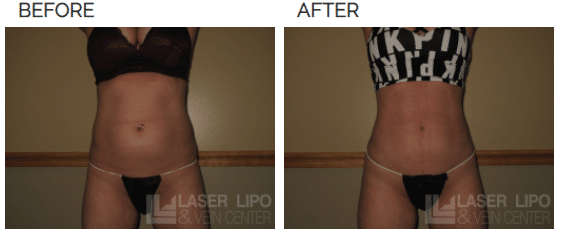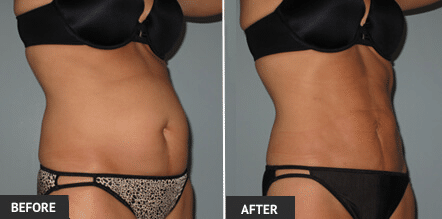When liposuction first became popular in the 1980s, treatments resulted in a large amount of bleeding, bruising, swelling, and painful recovery. These side effects quickly led plastic surgeons to search for techniques that could minimize these problems for their patients.
The first innovation was designed to make fat removal less traumatic and painful for the body. Providers discovered that injecting limited amounts of intravenous-like fluid to expand the “fat space” made it easier to remove stubborn fat deposits. Soon, small amounts of epinephrine (AKA adrenaline) were added to narrow blood vessels and decrease bleeding. This approach was known as the “wet” technique.

By the mid-1980s, tumescent fluid became a preferred local anesthetic, leading to the development of the tumescent liposuction technique and water-assisted liposuction technique. With tumescent liposuction, a local anesthetic, xylocaine (or Lidocaine), was added to provide numbing to the treated area in addition to the epinephrine (adrenaline). The tumescent technique was used primarily as local anesthesia and required that the amount of fluid injected into the treatment area was 3-4 times the amount of anticipated fat to be removed.
The disadvantage of this tumescent liposuction technique is that injecting large amounts of fluid increases the risk of toxic levels of xylocaine and epinephrine. While the technique itself removed more fat, this risk needed to be addressed to guard patient safety, leading to advancements that now make tumescent liposuction among the safest and most effective options available.
Tumescent Lipo Technique
The tumescent technique is one of the most popular liposuction treatments, gaining in popularity thanks to the many benefits it provides. Tumescent liposuction, unlike traditional liposuction, uses localized anesthetic instead of general anesthesia, so patients remain conscious through the entire procedure. Localized anesthetic is much safer to use for patients, causing little to no complications when compared to general anesthesia. Cosmetic surgeons use a tumescent fluid to surround the fat being removed, using a cannula to dislodge it from the connective tissue, and then suctioning it away. The tumescent liposuction technique allows for relatively quick recovery times and is an outpatient procedure.

Water Assisted Lipo Technique
The water-assisted liposuction technique (WAL) is theoretically thought to be the most gentle of all liposuction options, due to its unique approach to fat removal. While WAL also uses tumescent fluid, it changes the way fat is dislodged from the surrounding tissue. Water-assisted liposuction uses a pressure spray of tumescent fluid to dislodge the fat from the connective tissue, rather than utilizing a cannula and suction.

Thanks to the water pressure dislodging the fat instead, WAL does not cause unnecessary trauma to the area, however, it still uses a suction cannula to remove the fat. This, combined with the use of local anesthesia instead of general anesthesia, allows water-assisted lipo to be very gentle on the body and have a short recovery time for patients.
Risks of Anesthesia
A local anesthetic is by far the most common anesthesia used. Tens of thousands of medical and dental procedures are performed every day using local anesthetic safely and successfully in the United States. It is the safest form of surgical anesthesia and has a much lower risk overall than general anesthesia.
However, there are some limits to the amounts of local anesthesia that can be safely used during one procedure. The total dose of the local anesthetic, lidocaine, for example, is not unlimited. While a large area of the body can be treated in one surgery without exceeding the total safe dose, the whole body cannot be treated safely using a local anesthetic as the only anesthesia. If the safe dose is exceeded, serious side effects may occur, including seizures, arrhythmias, and even death could occur.
The Development of “Super Lipo”
“Super Lipo”, also referred to as “Super Tumescent Lipo” or “Super wet Lipo” is a technique of tumescent, water-assisted liposuction that uses local anesthesia for liposuction surgery in a way that is evenly distributed and rapidly infused into the treatment area. This treatment uses the tumescent fluid alongside intravenous hydration to numb the area regionally and is typically used in large-volume liposuction treatments (i.e, greater than 1500 ml removed) liposuction.
Benefits of the Super Lipo Technique
In the super-wet or Super lipo technique, the concentrations of xylocaine and epinephrine (numbing agents in local anesthetic) are the same as in the tumescent technique, but smaller volumes of fluid are used, generally, a 1:1 ratio of fluid injected to fat removed. The “Super Lipo” technique has proven to be an effective method for reducing the patient’s level of blood loss and increasing the volume of fat removed, allowing less bruising and increased recovery time.
Advantages offered by this advanced tumescent liposuction technique include:
- Reduced pain and discomfort
- Less risk of bruising
- Decreased bleeding and hemorrhaging risk
- Less risk of damage to surrounding muscle and tissue
Risks of the Super Lipo Technique
The super-wet technique is similar to tumescent liposuction. The difference is that not as much fluid is used during the surgery. The amount of fluid injected is equal to the amount of fat to be removed. This technique takes less time, but it often requires sedation (medicine that makes you drowsy) or general anesthesia (medicine that allows you to be asleep and pain-free).
While significantly safer than traditional liposuction and much less risky than older tumescent techniques, the super-wet liposuction method is a surgical procedure that comes with some risks. These include:
- General surgical complications
- Organ or tissue damage
- Visible scarring
- Uneven results
Which Option is Right For You?
The cost associated with lipo in St. Louis will vary according to the area of the body being treated. It’s important that patients discuss costs with their physician prior to the procedure in order to fully understand treatment charges. In the majority of cases, laser-assisted liposuction is categorized exclusively as a cosmetic procedure. The cost of elective treatments is often not covered by insurance companies. In the event of non-insurance coverage, the staff at the St. Louis laser liposuction Center are happy to provide information on alternative financing options such as Care Credit. Feel free to contact us with any questions or to set up an initial consultation.
